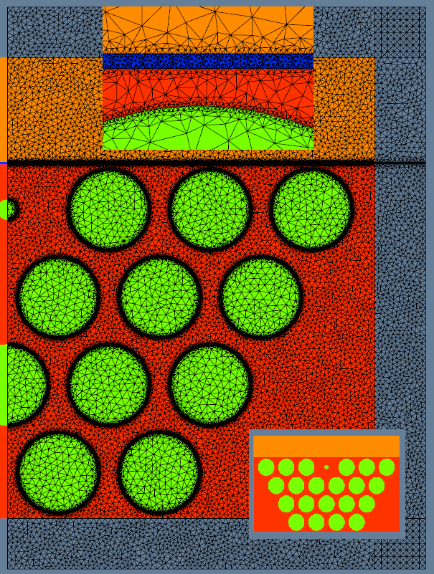Photonic crystal fibers (PCF) are attractive for chemical, biomedical, and environmental sensing applications. The freedom in designing the microstructure geometry for PCF environmental sensors provides a unique platform for realizing the desired modal dispersion, birefringence, confinement, and multiplicity characteristics. Chemical, biological, and inorganic materials, which can be introduced to the PCF by selective hole infiltration or deposition techniques, are of significant importance to these features.
Novel PCF sensor designs often encompass structural and electromagnetic field features spanning multiple orders of magnitude in variation. For example, the sub-wavelength metal films and tightly confined surface plasmonic modes in a PCF biochemical sensor with wavelength-scale mode and air-hole radii having cladding dimensions of 100 times the wavelength.
These properties require a mode solver that can both efficiently and accurately approximate the geometry and the electromagnetic fields over the entire simulation domain–that’s where OptiMode comes in.

Design, Simulate, and Build with OptiMode
From initial modeling to realistic simulations for real-world applications, OptiMode is fully equipped to help researchers and businesses build better sensors.
- Modeling: OptiMode can simulate the optical properties of PCF structures, enabling the exploration of different hole arrangements, sizes, and materials. This lets you optimize your PCF biochemical sensor design for specific sensing applications, such as maximizing sensitivity to a particular material.
- Visualization: When designing PCF environmental sensors, you can use OptiMode to visualize electric and magnetic field distributions. This helps in understanding how light interacts with the surrounding medium and how it can be influenced by changes in refractive index.
- Real-world Applications: Biochemical sensors are crucial in multiple fields. For instance, they can be used to respond to changes in chemical concentrations in real-time. OptiMode users can simulate this effect within the software itself.
Learn more about Optiwave applications here, or check out a webinar for a more interactive look at our software.
Full Application Note


